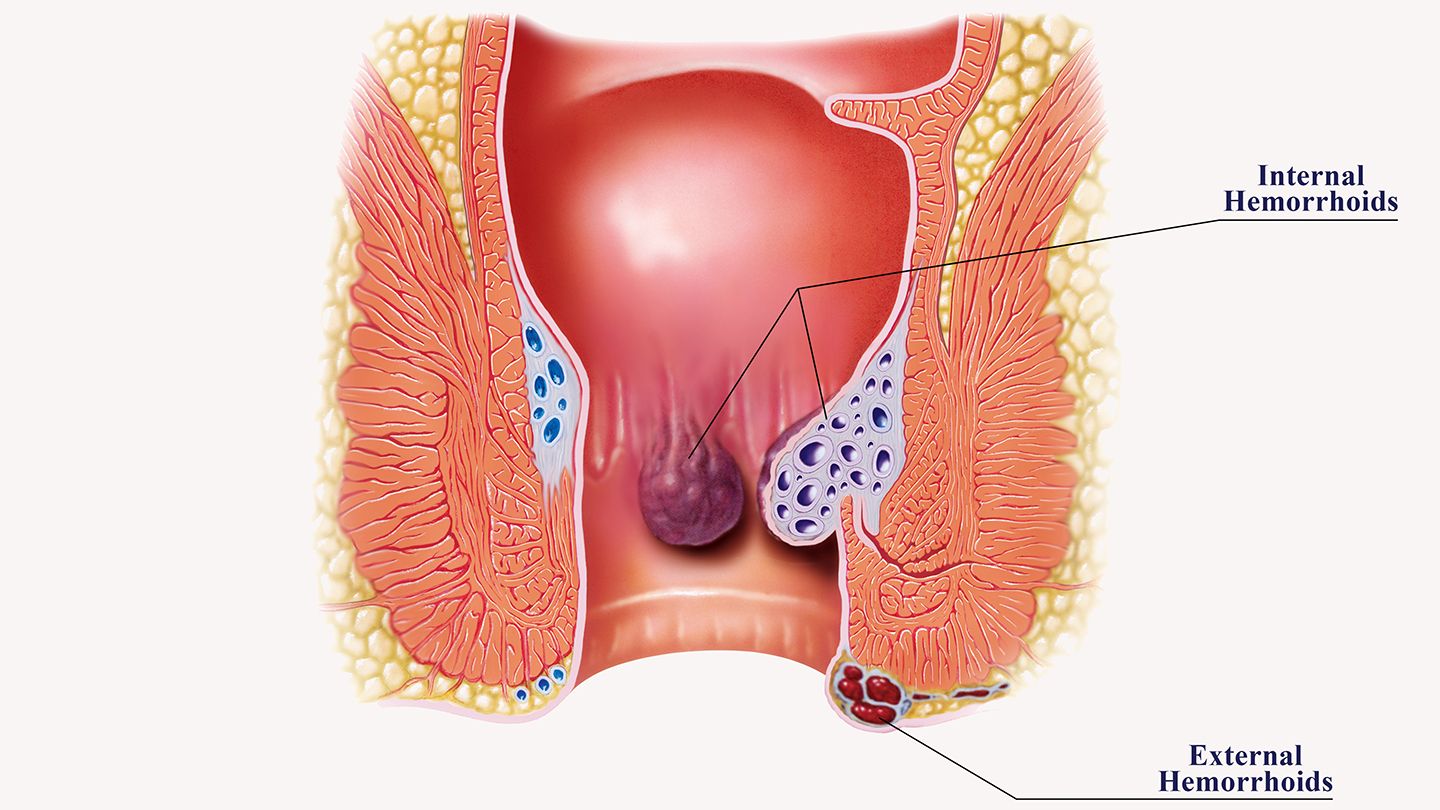A hemorrhoid, also referred to as a pile, is a bulge that surrounds or occurs in the anal canal and has an expanded blood artery inside of it. A hemorrhoid can form when tissue in these places swells, probably as a result of constipation and excessive bowel movement pressure. Damage to the hemorrhoid can result in bleeding and pain. Hemorrhoids can also be caused by intense activity like heavy lifting.

Internal Hemorrhoids, which develop inside the rectum, rarely cause pain. However, bleeding can occur if you exert too much effort when passing stool.
External Hemorrhoids Under the anal skin, there are external hemorrhoids. They are frequently unpleasant and irritating. An external hemorrhoid may occasionally accumulate blood, clot painfully, and develop as a large mass around the anus. We refer to this as thrombosed hemorrhoids.
How can you prevent hemorrhoids?
Consume meals high in fibre, such as fruits, vegetables, and whole grains. This will soften your stools, give them more weight, and stop the straining that can lead to hemorrhoids. Try to eat 25 to 35 g or more of high-fiber meals every day.
Dr. Dacha suggests over-the-counter fibre supplements like psyllium (Metamucil) or methylcellulose if you struggle to maintain your dietary consumption (Citrucel). Additionally, he adds that patients can take stool softeners like docusate sodium to make their stools soft and have more bowel movements.
What common habit can lead to hemorrhoids?
Many of my patients are shocked to find that prolonged use of the restroom can also result in hemorrhoids. Pressure is increased on the rectum and anus because of the design of the toilet seat. When you sit there for a long time, this may cause the veins to swell. The risk of hemorrhoids increases when you push forcefully during a bowel movement.
Some people take longer than others to empty their bowels. But when I inquire about my patients’ restroom practises, I frequently learn about one that is causing their hemorrhoids: smartphone use. Yes, a lot of us waste too much time browsing the internet while using the restroom.
What are the symptoms of hemorrhoids?
The following indications and symptoms may be experienced by a person who has hemorrhoids. These could also vary based on the type of hemorrhoid a person has.

Hemorrhoids that are external: These appear under the skin, close to the anus. The signs and symptoms include:
Someone could bleed.
Around the person’s anus, there could be edoema.
There may also be suffering and discomfort.
In the anal region, a person could experience itchiness and irritation.
Internal hemorrhoids: These hemorrhoids develop inside the person’s rectum. They are not visible or haptic. When someone is having a bowel movement, there could be some mild bleeding.
Hemorrhoids with thrombosis: These are the symptoms and indicators of this form of :
- Inflammation
- a mass close to the anus
- Swelling Painful severe
Causes of haemorrhoids
Over time, Hemorrhoids slowly grow. Deoxygenated blood is returned to the heart through tiny veins and blood capillaries in and around the rectum and anus. These tiny blood arteries and veins may swell with blood and eventually become obese and knobby if the return blood flow is restricted.
- The major causes of hemorrhoids are: heavy physical labour, hereditary factors, pregnancy, straining on the toilet due to constipation, and additional weight and pressure on the bowels.
- Long periods of time spent sitting on hard surfaces might also contribute to developing.
Treatment
In hospitals across the United States, fewer patients are needing hemorrhoidectomy, the surgical removal of . With 117 hemorrhoidectomies per 100,000 individuals, it peaked in 1974 before falling to 37 in 1987.
How can I tell if I have hemorrhoids?
If you suspect that you may have hemorrhoids, there is a good likelihood that you are correct because they are difficult to notice. Typical warning signs and symptoms include:
- Anal region pain, especially when sitting or bending over. Cleaning or rubbing the area could exacerbate the pain.
- itchiness in the anal region.
- a sensation of skin poking out when having bowel motions.
- bleeding when having a bowel movement, which can be seen as blood in the toilet bowl, on the toilet paper after wiping, or in your stool.
- lumps that are sensitive around the anal region.
What food to avoid in hemorrhoids?
The following foods should not be consumed by anyone who has .
- Meat that has been processed usually implies that a lot of preservatives have been added, which can be highly bad for a person’s digestive system.
- People consume polished rice, which is all white and devoid of any fibre or nutrients. Rice is full of starch once it has been polished. It indicates that they are entirely composed of carbohydrates, which can cause constipation.
- Food that has been deep-fried should be avoided because it not only loses all of its nutritious content but also damages the liver.
Do I need to see the doctor for a hemorrhoid?
Hemorrhoids can be treated at home, but if your symptoms don’t go away after a week, you should see a doctor. A hemorrhoid may occasionally become infected. Rectal bleeding can also be a symptom of more serious disorders including Crohn’s disease, ulcerative colitis, and colon cancer, so getting it checked out is crucial if it isn’t getting better
Conclusion
Millions of Americans suffer from the common yet difficult illness known as . The condition must be distinguished from other anorectal disorders, and the symptoms must be thoroughly assessed to rule out other symptom-mimicking entities. There are many alternatives for managing hemorrhoid illness, and the decision of a particular course of action should be dependent on the particular patient and their clinical circumstances.
